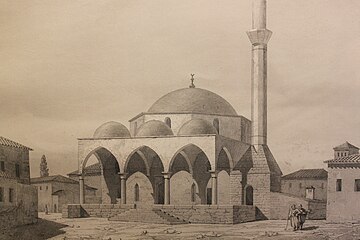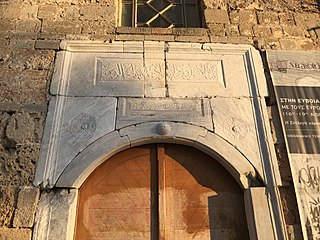|
Emir Zade Mosque
The Emir Zade Mosque (Greek: Εμίρ Ζαδέ Τζαμί, from Turkish: Emirzade Camii, lit. 'Mosque of the Emir's son') is a historical Ottoman-era mosque in the town of Chalcis, on the island of Euboea, Greece. It is now a museum non-accessible to the public. HistoryThe mosque was built shortly after the fall of Euboea to the Ottomans in the 15th century, and it was one of the three mosques within the walled city.[1] Evliya Çelebi, an Ottoman explorer and traveller, visiting Chalcis in the 17th century, noted eleven mosques including Emir Zade.[2] The minaret and portico survived intact until around the mid-19th century, based on a watercolor picture by Andre Couchaud in 1843.[2] Following the Greek War of Independence in 1821 and the liberation of Chalcis from the Ottoman Turks, it was converted into a barracks.[1] In 1937 it was declared a historical monument, and today it houses part of the medieval archaeological collection of Chalcis, however the museum is not open to the public.[1] Since the late 1950s the building has been gradually restored while in the period 1970 to 1973 period it underwent restoration work.[2] ArchitectureOutside the Ottoman mosque there are remains of an earlier Christian church which was converted into a mosque.[2] The Emir Zade Mosque is of a simple architectural style of single-dome mosque, like most in Greece and the rest of the Balkans.[2] Aside from the lost portico and minaret, the mosque survives almost intact. It consists of a rectangular room covered by a dome which is hemispherical inside and octagonal outside, resting on four semi-conical domes. On the west side there by columns gallery, the revak, roofed with hemispherical calotte. The cylindrical minaret used to stand on the southwest side; only the square base is left.[2] The marble slabs of the entrance frame have inscriptions in Arabic, which read “enter here in peace and will be immortal in the name of all-merciful God.” The interior of the mosque is illuminated by two parallel rows of windows. Inside, the niche of the mihrab was placed in the east wall, where traces of colour and the original décor still remain. Two more marble plaques inscribed with excerpts from the Quran in Arabic crown the arch.[2] Preserved is also the fountain in the yard, bearing inscriptions and decorated with elaborately embossed Arabic art,[2] built in 1655.[1] Scattered around the mosque are several fragments of ancient columns and capitals.[1] Civil engineer, Giannis Karalis, made the following observation: "The Emir Zade mosque–like several of those preserved in Greece–is of particular interest due to its relationship with Byzantine architecture, by which it was clearly influenced, as well as its integration into the medieval Greek settlements. The study, however, has not yet progressed."[1] Gallery
See alsoReferencesExternal links
|
||||||||||||||||||||||||||||||||||||||||||






